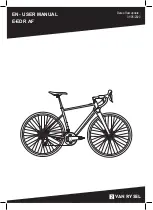
65
Last Modifi ed June 23, 2014 5:19 PM
Perspective
65
EBCC Technical and Customer Service: +1 800-377-4532
Appendix - Lifespan.indd
The lifespan of your bike and its components
Perspective
Frequent inspection of your bike is
important to your safety. Follow the
Mechanical Safety Check on page 5
of this Manual before every ride.
Periodic, more detailed inspection of
your bicycle is important. How often
this more detailed inspection is needed
depends upon you.
You, the rider/owner, have control and
knowledge of how often you use your
bike, how hard you use it and where you
use it. Because your dealer cannot track
your use, you must take responsibility
for periodically bringing your bike to
your dealer for inspection and service.
Your dealer will help you decide what
frequency of inspection and service is
appropriate for how and where you use
your bike.
For your safety, understanding and com-
munication with your dealer, we urge you
to read this Appendix in its entirety. The
materials used to make your bike deter-
mine how and how frequently to inspect.
Ignoring this WARNING can lead to
frame, fork or other component failure,
which can result in serious injury or
death.
Understanding metals
Steel is the traditional material for building
bicycle frames. It has good characteristics,
but in high performance bicycles, steel has
been largely replaced by aluminum and
some titanium. The main factor driving this
change is interest by cycling enthusiasts
in lighter bicycles.
Properties of Metals
Please understand that there is no simple
statement that can be made that charac-
terizes the use of different metals for bicy-
cles. What is true is how the metal chosen
is applied is much more important than the
material alone. One must look at the way
the bike is designed, tested, manufactured,
supported along with the characteristics of
the metal rather than seeking a simplistic
answer.
Metals vary widely in their resistance
to corrosion. Steel must be protected or
rust will attack it. Aluminum and Titanium
quickly develop an oxide fi lm that protects
the metal from further corrosion. Both are
therefore quite resistant to corrosion. Alu-
minum is not perfectly corrosion resistant,
and particular care must be used where it
contacts other metals and galvanic corro-
sion can occur.
Metals are comparatively ductile. Ductile
means bending, buckling and stretching
before breaking. Generally speaking, of
the common bicycle frame building mate-
rials steel is the most ductile, titanium less
ductile, followed by aluminum.
Metals vary in density. Density is weight
per unit of material. Steel weighs 7.8 grams/
cm3 (grams per cubic centimeter), titanium
4.5 grams/cm3, aluminum 2.75 grams/cm3.
Contrast these numbers with carbon fi ber
composite at 1.45 grams/cm3.
Metals are subject to fatigue. With enough
cycles of use, at high enough loads, metals
will eventually develop cracks that lead to
failure. It is very important that you read
The basics of metal fatigue below.










































